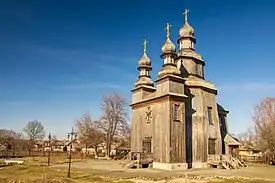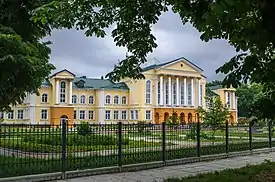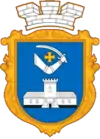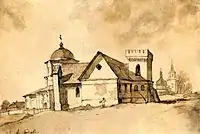Sedniv
Sedniv is a small urban-type settlement in Chernihiv Oblast, Ukraine. It is located in Chernihiv Raion. Population: 1,078 (2020 est.)[1]
Sedniv (Седнів) | |
|---|---|
Town | |
    | |
 Flag | |
| Country | |
| Oblast | Chernihiv Oblast |
| Municipality | Sedniv municipality |
| Population (2020) | |
| • Total | 1,078 |
| Postal code | 14000 |
| Area code(s) | (+380) |
| Vehicle registration | CB / 25 |
Sedniv is famous for being the hometown of the Cossack Lyzohub family. The population of Sedniv suffered from Holodomor and in 1932 it lost its status of town in part due to the effect of the Soviet Union's 'Blackboard Policies'. From 1932-1959 Sedniv was a village.
Sedniv is located at the location of the Ruthenian city of Snovsk that was destroyed by the Tatars in 1239. It is unknown when the town changed its name. It is known that in 1648-1781 it was a district (sotnia) seat of the Chernihiv region (polk).
History
Dolitopysna period (Chronicles)
Current research indicates the settlement called Sedniv in VII.century was named such by Danish colonialists.[2] The prototype was from the name of the Danish settlement Seden.[3] After the conquest of the lands now called Chernihiv by the Rurik Dynasty - the area was subsequently called Snovesk.
The Kyiv State
In the chronicles first mentioned as sources of the ancient city-fortress Snovsk. Near him in 1068 Prince Svyatoslav with three thousand soldiers broke the 12 thousandth Polovtsian army. The name comes from the River Snov ("sleep" - wash, bathe). Folk legend tells other versions of the town's name:
"The devastating hordes of the Crimean Tatars attacked Snovsk, but could not take the city-fortress. The Tartars then called the defending city of Snovsk "Sidnaame"(сидняме), which translated from Tatar language as if to mean evil and brave. Hence - Sedniv."
In the X - XI. centuries, Snovsk was one of the strongholds of Kyivan Rus, the center of a separate administrative unit - Snovskian Thousand.
In the XII-XIII. centuries, Snovsk was part of the Chernihiv principality but later destroyed by Tatars invaders in 1239.
In the mid-XIV. century, the city became part of the Grand Duchy of Lithuania.
The Hetman Times

The drawing on the left is the Kamianytsia Lyzohub, 1846 a depiction of the Lyzohub stone-house created by Ukrainian icon, Taras Shevchenko in 1846.
1648-1781 - Sedniv was sotnia town within the Chernihiv Regiment, and later - the parish town of Little Russia, then in the Chernihiv province. In 1659 there was a short time it was a part of Sednivskyy Regiment.
At the end of the XVII. century, Sedniv became a chattel to the Cossack family Lyzohub.
Since 1782 - it was in the national district of the Chernihiv province, then in 1797 - the center of the parish of the same district called the Little Russian province, and from 1802 - back to the Chernihiv province.
Russian annexation
In the middle of the XIX. century, the city was divided into two parts: Mills and Tanners.
Day of UNR
1917 Sedniv joined the Ukrainian People's Republic "UNR".
January 20, 1918 Sedniv first Russian Bolshevik gang appeared.
March 18, 1918 Sedniv was released by German and Ukrainian troops.
January 10, 1919 in Sedniv there was a battle between soldiers of the army of UPA and red Bogunskiy regiment. 25 killed in the battle of UPA soldiers buried at the local cemetery.[4]
The Soviet Era
In August 1920, the Communist Sednivska village council began. In March 1923, Sednivska parish was included in the Gorodnya district and Sedniv became the center of the village council. Since August 1929 Sednivska village council has been a part of the Chernihiv region.
Holodomor 1932-1933
The city suffered from the genocide of 1932-33s, which stemmed from the Soviet authorities because of the massive resistance of the occupied territories of the UNR region. In 1932 within the village there was mass disobedience, with many attacking those who actively collaborated with the Communists - the Komsomol, because they robbed the elderly people and large families.
Given the systematic resistance[5] confiscation of illegal products, the submission of Chernigov district committee of the CP (B) U, city languished under the 'Black-board', its status was eventually downgraded to that of village.[6]
Being one of 13 settlements in the Chernihiv region that were under the 'Blackboards' many experienced deep psychosis from starving hunger with reported cannibalism, mass death, infectious disease and hunger shock. The hardest hit population group were those under 15 years of age.[7]
Administrative
The village is on the list of historic settlements of Ukraine approved by the Cabinet of Ministers of Ukraine in 2001.[8]
Geography and Climate
The village is located on the River. Snov, and sits about 25 km from the railway station in Chernihiv.
Demographics
Population Data
| 1959 | 1979 | 1989 | 2001 | 2016 |
|---|---|---|---|---|
| 2395 | 1930 | 1836 | 1351 | 1103 |
Population Distribution by Native Language (2001)
| Ukrainian | Russian |
|---|---|
| 95,86% | 3,92% |
Culture
Historical Sites
.jpg.webp)
1. St. George's church : is a wooden church of St. George (George), built no later than 1747, according to legend - even in the 17th century.[9]
2. In Sedniv remains of the remains of its ancient city walls.
3. Manor Lyzohub based Chernihiv Colonel James Lizogubom, created from the late 17th to the beginning of the 20th century.
4. Church of the Resurrection, tribal tomb Lyzohub, 1690.
5. Museum Chernihiv energy.[10]
Gallery
.JPG.webp) Воскресенська церква
Воскресенська церква Кам'яниця Лизогубів
Кам'яниця Лизогубів.JPG.webp) Кам'яниця Лизогубів
Кам'яниця Лизогубів.jpg.webp) Світанок в Седневі
Світанок в Седневі Альтанка Глібова
Альтанка Глібова Пам'ятник Л. Глібову
Пам'ятник Л. Глібову Пам'ятник Аркадію Казці
Пам'ятник Аркадію Казці Садиба Лизогуба
Садиба Лизогуба р. Снов у Седневі
р. Снов у Седневі Вид на пам'ятки Седнева з р. Снов
Вид на пам'ятки Седнева з р. Снов Георгіївська церква в Седневі (2012)
Георгіївська церква в Седневі (2012) Воскресенська церква із дзвіницею в Седневі
Воскресенська церква із дзвіницею в Седневі Нова Седнівська школа
Нова Седнівська школа Вид на р. Снов з оглядового майданчика Седнева
Вид на р. Снов з оглядового майданчика Седнева Вид на церкви Седнева з р. Снов
Вид на церкви Седнева з р. Снов
References
- "Чисельність наявного населення України (Actual population of Ukraine)" (PDF) (in Ukrainian). State Statistics Service of Ukraine. Retrieved 30 September 2020.
- Тищенко К.М. "Халіфат і Сівера: топонімічний слід в Україні". Київ, 2011, с. 272-275.
- da:Seden
- Ервін Міден. Полум'яні літа української революції: події в Седневі // Сайт УІНП
- «Червоний стяг» (Чернігів). — 1932. — 25 жовтня. — № 304
- Перелік населених пунктів України занесених на «Чорні дошки» у 1932–1933 роках. Смт. Седнів
- Перелік населених пунктів України занесених на «Чорні дошки» у 1932–1933 роках
- Постанова Кабінету Міністрів України від 26 липня 2001 р. №878 «Про затвердження Списку історичних населених місць України»
- Світлини церкви Святого Юра (Георгія) в с. Седнів
- В Седневе открыли уникальный музей энергетики, gorod.cn.ua, 22 грудня 2015
External links
- Brief information at the Verkhovna Rada website
- Sedniv at the Castles and temples of Ukraine website